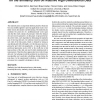37 search results - page 1 / 8 » Where the Typical Set Partitions Meet and Join |
COMBINATORICS
2000
13 years 4 months ago
2000
The lattice of the set partitions of [n] ordered by refinement is studied. Suppose r partitions p1, . . . , pr are chosen independently and uniformly at random. The probability tha...
VLDB
1994
ACM
13 years 9 months ago
1994
ACM
This paper presents an innovative partitionbased time join strategy for temporal databases where time is represented by time intervals. The proposed method maps time intervals to ...
ICDT
2009
ACM
14 years 5 months ago
2009
ACM
Partitioning is an important step in several database algorithms, including sorting, aggregation, and joins. Partitioning is also fundamental for dividing work into equal-sized (o...
SIGMOD
2001
ACM
14 years 5 months ago
2001
ACM
The similarity join is an important database primitive which has been successfully applied to speed up applications such as similarity search, data analysis and data mining. The s...
SIGMOD
1997
ACM
13 years 8 months ago
1997
ACM
The Partitioned Based Spatial-Merge Join (PBSM) of Patel and DeWitt and the Size Separation Spatial Join (S3 J) of Koudas and Sevcik are considered to be among the most efficient ...


